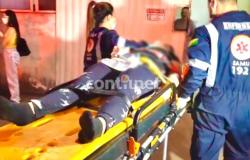Bocaina de Minas is a municipality in the south of Minas, on the border with the state of Rio de Janeiro, and is part of the Itatiaia National Park. Livestock farming, especially the production of artisanal cheeses, is the main activity among small local producers, but blackberries, a dark and very tasty fruit, have also gained space in many places in the area.
According to Emater-MG, in 2023, the average production of blackberries in Bocaina de Minas was 96 tons, in a total area of 7 hectares.
The blackberry is a shrubby plant with an erect or creeping shape, producing fruits weighing around 4 to 7 grams, black in color and with an acidic flavor. Fresh fruit is highly nutritious, with lots of water and a high amount of minerals and vitamins C, B and A. The fruits can be consumed fresh or in the form of jellies, juices, paste and fermented sweets. They can be frozen and used as pulp to make ice cream, yogurt and pies.
Cold weather
Emater-MG extension agent, Rodrigo Cavalcanti Ferreira, explains that the region is famous for its natural beauty and that is why it attracts many people from outside, who have farms there. “People come and like to plant red fruits to make juices and jellies. So the cultivation of blackberries did not come about as a commercial proposal, but it has good potential as it is a region with a cold climate and a tourist vocation”, says the technician.
The crop is a great alternative for small producers, who seek to diversify their production, due to its ease of management and because it does not require large areas. The activity can also have added value, with the processing of production (sweets, jellies and other derivatives).
Producer Danilo Costa de Almeida, current secretary of Agriculture for the municipality, began growing blackberries in December 2020, with technical assistance from Emater-MG. Currently, he has 300 blackberry trees, in an area of two thousand square meters. “The region has a favorable climate for cultivation. It is a robust plant, easy to manage and produces quickly. After a year, you already have a harvest”, explains the farmer.
Need to freeze
According to Danilo, the most complicated thing is that it is a very perishable fruit. “You harvest in the morning and everything has to be frozen by noon, otherwise it will be lost. So you need to have a freezer and transport it without defrosting it. But as the blackberries are frozen, I can sell them at times of lower supply and better prices”, explains Danilo. The blackberry harvest period runs from November to February.
In the region, blackberries are sold by some farmers through the National School Feeding Program (PNAE) and sold in nearby municipalities, especially in cities in Rio de Janeiro that receive many tourists, such as Visconde de Mauá.
In addition to spoiling easily, another difficulty with blackberries, according to the Emater-MG extension agent, is the need for annual pruning of the plant. “Many people don’t prune properly because of the plant’s thorns. But in general, it is very resistant, including frost, which is very common in the region”, argues Rodrigo.
Brazilian production of the main temperate fruit species is insufficient to meet domestic demand, generating a growing need to import fruits that, in principle, can be produced in Brazil.
The black mulberry tree (Rubus spp) is one of the species that has shown significant growth in cultivated area in recent years in Rio Grande do Sul (main Brazilian producer) and has high potential for regions with a suitable microclimate, such as Santa Catarina, Paraná, São Paulo and Southern Minas Gerais.
(Mines Agency)
Post Views: 4
Tags: Blackberry diversifies agricultural production south Minas
--




